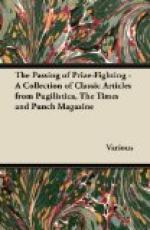The Romance of Madame Tussaud’s (ODHAMS) strikes one, in these days of universal reminiscence, almost as a libre a faire, certainly as a volume that finds its welcome waiting for it. I suppose there are few unhappy beings for whom the very name of that gifted lady does not revive something of the nursery magic that is never quite forgotten. All of which means that Mr. JOHN T. TUSSAUD, who has written, vivaciously and with obvious pleasure, this history of the famous show, is (I hope) assured beforehand of his sales. It is a fat record, taking the story from the earliest wax profiles made by Dr. CURTIUS for the Parisian aristocracy in the days before the Revolution; through the Terror, when his niece (afterwards Madame TUSSAUD) was employed to model notable heads from the basket of the guillotine, which was itself subsequently to figure amongst the attractions of her collection, and finally bringing the enterprising artist and her models to England and Baker Street, whence a comparatively recent move established them (the foundress in effigy only) in their present palace. I was especially interested to trace the evidence of close attention paid to the show by Mr. Punch, and in particular to learn that the title Chamber of Horrors was first invented by that observer; though the author falls into an obvious chronological inexactitude in ascribing to these pages a cartoon by CRUIKSHANK published “in November of Waterloo year.” I have no space for the many queer stories, chiefly of encounters between the quick and the wax, with which the book abounds, nor for more than mention of its admirable photographs, of which I should have liked many more. Altogether it gives an unusual sidelight on the history of two Capitals; and incidentally, if the reading of it puts others in the same resolve as myself, an extra turn-stile will be needed in the Marylebone Road.
* * * * *
Mr. HARRY TIGHE is something of a problem to me. With the best will in the world to appreciate what looked like unusual promise I can only regard him at present as one who is neglecting the good gifts of heaven in the pursuit apparently of some Jack-o’-lanthorn idea of popularity. No doubt you recall his first novel, The Sheep Path, a sincere and well-observed study of feminine temperament. This was followed by one that (though it had its friends) marked, to my thinking, a lamentable fall from grace. He has now published a third, Day Dawn (WESTALL). Here, though popularity of a kind may be its reward, the work is still woefully beneath what should be Mr. TIGHE’S level. Certainly not one of the demands of the circulating libraries is unfulfilled. We have a fair-haired heroine (victim to cocaine), a dark and villainous foreigner, a dashing hero, a middle-aged woman who adores him despite the presence of her husband, himself called throughout Baron Brinthall, a style surely more common in pantomimic




